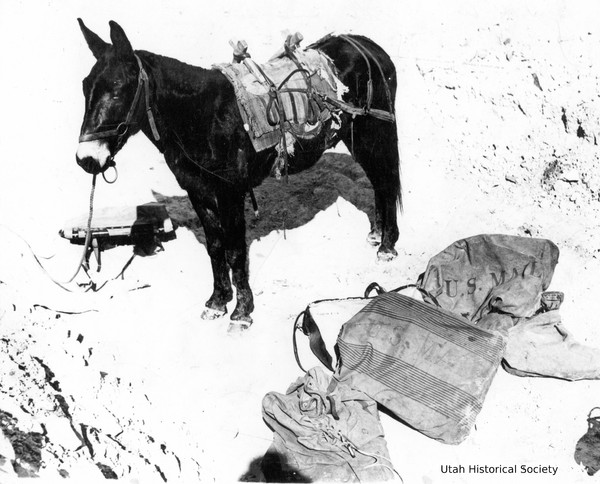Dublin Core
Title
The Death Hollow Trail: Delivering Mail by Mule to Boulder
Description
Today, our mail is delivered in large trucks and often takes just a day or two to reach its final destination. But for one Utah town, mail was delivered by mule well into the twentieth century.
Rain, sleet, snow, or hail, we expect mail to be delivered no matter the weather or road conditions. But, for Boulder, located northeast of Escalante in Garfield County, the journey was more complicated than just inclement weather. In the early 1900s, Boulder was considered one of the most isolated towns in the United States. In fact, the rural community was so isolated, that for decades they received their mail by mule train!
At just over 25 miles away, Escalante was something of a close neighbor to Boulder. A fairly direct trail between the towns offered a way to communicate and conduct business. However, the US Postal Service avoided regular deliveries to Boulder until the trail was improved in 1902. Despite improvements, the trail remained incredibly dangerous. Passing through Death Hollow Canyon, mail carriers on the “Boulder Mail Trail” hauled letters and packages on a steep trail over broken slickrock and dangerous dry sand. It was not uncommon to have horses and mules get stuck in sand or mail carriers choke during windstorms. Wet or snowy weather made the trail impassable, and mail carriers were forced to use a longer, slower alternate route to Boulder that avoided Death Hollow.
One postman was very familiar with the days-long journey on the trail between Boulder and Escalante. From 1934 to 1938, Franklin Hansen delivered packages along the Boulder Mail Trail. Accompanied by a horse and a few mules, Hansen sometimes spent six days a week traversing the remote landscape on horseback. Animals were loaded with letters, packages, and by some accounts, sewing machines.
The mule train connected members of the rural community with the world outside of Boulder. Many families left town only a few times a year to purchase supplies. Without paved roads, the mule train was vital for Boulder residents and businesses. Even after the Hell’s Backbone Road opened in the mid-1930s, few people made regular trips out of Boulder. Although Boulder remains fairly isolated, year-round roads and proximity to public lands have changed the community over the last few decades - including retiring the mule train.
Rain, sleet, snow, or hail, we expect mail to be delivered no matter the weather or road conditions. But, for Boulder, located northeast of Escalante in Garfield County, the journey was more complicated than just inclement weather. In the early 1900s, Boulder was considered one of the most isolated towns in the United States. In fact, the rural community was so isolated, that for decades they received their mail by mule train!
At just over 25 miles away, Escalante was something of a close neighbor to Boulder. A fairly direct trail between the towns offered a way to communicate and conduct business. However, the US Postal Service avoided regular deliveries to Boulder until the trail was improved in 1902. Despite improvements, the trail remained incredibly dangerous. Passing through Death Hollow Canyon, mail carriers on the “Boulder Mail Trail” hauled letters and packages on a steep trail over broken slickrock and dangerous dry sand. It was not uncommon to have horses and mules get stuck in sand or mail carriers choke during windstorms. Wet or snowy weather made the trail impassable, and mail carriers were forced to use a longer, slower alternate route to Boulder that avoided Death Hollow.
One postman was very familiar with the days-long journey on the trail between Boulder and Escalante. From 1934 to 1938, Franklin Hansen delivered packages along the Boulder Mail Trail. Accompanied by a horse and a few mules, Hansen sometimes spent six days a week traversing the remote landscape on horseback. Animals were loaded with letters, packages, and by some accounts, sewing machines.
The mule train connected members of the rural community with the world outside of Boulder. Many families left town only a few times a year to purchase supplies. Without paved roads, the mule train was vital for Boulder residents and businesses. Even after the Hell’s Backbone Road opened in the mid-1930s, few people made regular trips out of Boulder. Although Boulder remains fairly isolated, year-round roads and proximity to public lands have changed the community over the last few decades - including retiring the mule train.
Creator
By Mikee Ferran for Utah Humanities © 2023
Source
Image: A postal pack mule on its way to Boulder, c. 1920. Donkey-driven mail delivery to the isolated town was used until about 1935. Image courtesy Utah Historical Society.
________________
See Boulder, Utah | Southern Utah's Gateway to Quiet Recreation, Dark Skies, and Slickrock Hiking; “The Boulder Mail (AKA Death Hollow) Trail,” The History Blazer, September 1996; Ruth Ann Mitchell, “Boulder Re-enacts Mule-Train Postal System”, Deseret News, July 19, 1996; “Mail Call in Rural Utah,” The History Blazer, November 1995
________________
See Boulder, Utah | Southern Utah's Gateway to Quiet Recreation, Dark Skies, and Slickrock Hiking; “The Boulder Mail (AKA Death Hollow) Trail,” The History Blazer, September 1996; Ruth Ann Mitchell, “Boulder Re-enacts Mule-Train Postal System”, Deseret News, July 19, 1996; “Mail Call in Rural Utah,” The History Blazer, November 1995
Publisher
The Beehive Archive is a production of Utah Humanities. Find sources and the whole collection of past episodes at www.utahhumanities.org/stories.
Date
2023-10-20

